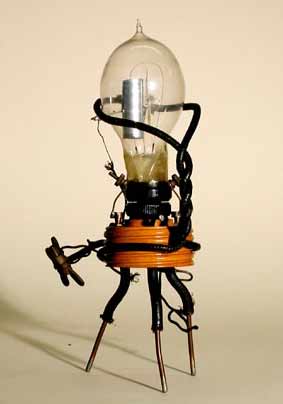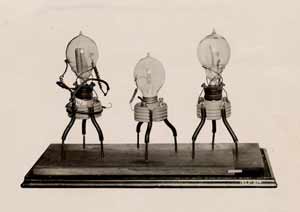Fleming's Oscillation Valve or Diode
Thermionic technology, and even electronics was born with Ambrose Fleming's 'Oscillation Valve' or diode valve invention.
History of the Valve / Tube Includes:
History overview
Early discoveries
Fleming's oscillation valve
de Forest's Audion
Development of the basic idea
R-type valve
6L6 valve
EF50 valve
The invention of the first diode valve is credited to Ambrose Fleming who, in 1884 joined University College London taking up the Chair of Electrical Technology, the first of its kind in England.
Fleming initially worked on what would be termed today as electrical science and his named is remembered as well for Fleming's Left Hand Motor Rule.
Fleming had also undertaken ground breaking work on electrical measurements and even today he is remembered for this.
Scene is set for the diode valve invention
In the late 1800s Marconi had been experimenting with wire-less technology as it was known then. While some had seen the new wireless technology as an interesting phenomenon, Marconi had seen a business opportunity and had sought to find real applications for it. One major area was that of communication with shipping as they had no form of beyond line of sight communication. As a result Marconi wanted to develop the technology and increase the distance over which signals could be heard.
Marconi set up his company: 'Wireless Telegraph and Signal Company Limited' in Britain in July 1897. Fleming became a consultant to Marconi and it was Fleming who developed the transmitter that was used for the first transatlantic transmission in 1901.
Initially Fleming had focussed on the transmitting equipment, but later he turned his attentions to the receiving technology. Fleming was acutely aware of the limitations of methods of detecting wireless signals. The coherers, magnetic detectors and other forms of detector available at this time were very insensitive and required significant signal levels to operate. In addition to this they were unstable and very unreliable.
As a result Fleming needed to come up with better forms of signal detection.
Initial work
Fleming's initial work as a precursor to what eventually became his oscillation valve involved trying to detect radio or wireless signals using a method a technique that could operate a mechanism of some form. Fleming suffered from worsening deafness and therefore a system that used a visual indication would be greatly beneficial.
As a result Fleming looked at using an instrument that detected current. The most sensitive one was a d'Arsonval mirror galvanometer. To use this Fleming needed to be able to rectify the high frequency signals or oscillations.
Fleming tried several forms of rectifier that were available at the time, but none of them worked. For the time being this idea had to lay dormant.
Thermionic technology
Fleming eventually found the solution to the problem of rectifying radio frequency signals in light bulb technology.
Like Edison, Fleming had been also fascinated by what was termed the Edison Effect. Fleming performed some experiments around the idea and in 1889 he had some bulbs made up for him by the Ediswan Company in the UK.
Using these bulbs he reproduced the Edison Effect, although again this was performed using a steady state charge. It was not until a few years later that he observed that if an alternating current with a frequency between 80 and 100 Hz was passed through the bulb, then only one half of the cycle was passed. In other words it was rectified to produce a direct current.
At this time there was a lack of understanding about the operation of the device and this prevented further progress from being made. However the situation improved when Sir Joseph Thomson discovered that atoms were made from even smaller particles, one of which was a negatively charged particle, an electron. Accordingly it was quickly realised that it was electrons that were being emitted from the heated filament in the bulb, and it also provided the reason why they were attracted to an electrode with a positive charge.

Fleming's Oscillation Valve
Marconi plc - with permission
In November 1904, with ideas in his head about developing better ways of detecting radio signals and the need to rectify them, he had what he called "a sudden very happy thought" whilst he was walking along Gower Street in the West End of London.
Fleming wondered if the Edison Effect could be used to rectify what he called the "feeble to and fro motions of electricity from an aerial wire". Fleming instructed his assistant to set up an experiment and to their great exhilaration they were quickly able to prove that the idea worked.
In his own words, Fleming wrote:
"Then and there I determined to see if they [the electric light bulbs or lamps] would serve the purpose. I went to a cabinet and brought out the same lamps I had used in my previous investigations. My assistant helped me to construct an oscillatory circuit with two Leyden jars, a wooden frame, and an induction coil. We then made another circuit, in which we inserted one of the lamps and a galvanometer, afterwards tuning it to the same frequency as the first circuit."
"It was about five o'clock in the evening when the apparatus was completed. I was, of course, most anxious to try the experiment without further loss of time. We set the two circuits some distance apart in the laboratory and I started the oscillations in the primary circuit."
"To my delight I saw the needle of the galvanometer indicate a steady direct electric current passing through, and found we had in this peculiar kind of electric lamp, a solution to the problem of rectifying high frequency wireless currents."
J A Fleming, How I Put Electrons to Work in a Radio Bottle, Popular Radio, March 1923.

Fleming's Oscillation Valves
Marconi plc - with permission
Fleming's 'Oscillation Valve'
Fleming called his new invention an "oscillation valve" because it acted in a similar way to a valve in a pump that allows gas or water to move in only one direction.
Even though the vacuum tube was still in its infancy it was still a major improvement over the coherer or magnetic detectors that were available at the time.
Oscillation valve patent
Fleming quickly patented the idea for his oscillation valve as he was obviously ecstatic about his discover. In November 1904, shortly after the successful experiment, Fleming was seen "scudding down Gower Street" in London, oblivious to all around him on his way to patent the idea.
Fleming's British patent was filed on 16 November 1904 with the complete specification filed on 15 August 1905. The British patent was granted on 21 September 1905, Patent Number 24 850 of 1904.
Fleming also applied for patents in the USA and also in Germany. The US patent number was 803 684. However in his patent applications, Fleming claimed the invention, not only of the device, but also its application to rectification without limitations on frequency. It was this claim that later lead to the American patent being judged void, and opening up the field to others using Fleming's oscillation valve idea and building upon it.
Oscillation valve development
After Fleming had made his initial discovery about the oscillation valve and its rectification of radio signals, he started to undertake further work to enable it to be sued within Marconi's wireless systems.
He had some more valves made by Edison and Swan that could have their heater filaments run from a 12 volt battery.
He proceeded to plot their characteristic curves so that he could better understand their operation.
Fleming also presented a paper to the Royal Society on the 8th February 1905 in which he detailed the operation of the oscillation valve.
Fleming also sent Marconi five of his oscillation valves to be used and tested at Marconi's Poldhu wireless station in Cornwall. During these tests, it was found that the valves needed to be screened using copper gauze to prevent nearby 'electrically charged bodies' from disrupting their operation.
Fleming also carried out other experiments with his oscillation valve. He investigated the characteristics more thoroughly and also looked at how these changed when different filaments were used. This lead him to use the valve in a different configuration, operating the valve at the bottom of the characteristic curve by adjusting the anode potential and superimposing the signal on this steady DC bias. This mode of operation resulted in an increase in the level of sensitivity of the device.
Oscillation valve competition
Despite its clear advantage over other detectors, Fleming's oscillation valve or vacuum tube was not widely used. Valves or tubes were difficult and expensive to make and their heaters consumed large amounts of power and this had to be supplied by expensive batteries.
Additionally some cheaper devices were discovered in 1906. Devices that were forerunners of the Cat's Whisker detectors that were used in crystal sets until the mid-1920s were discovered. In fact two different patents were filed, one by Ferdinand Braun for a crystal detector using hydrated crystals of manganese oxide and the other by H. Dunwoody for a crystal detector using carborundum. These devices had many limitations but they were very much cheaper than Fleming's oscillation valve and as a result they were quickly adopted.
 Written by Ian Poole .
Written by Ian Poole .
Experienced electronics engineer and author.
More History:
Radio history timeline
History of the radio
Ham radio history
Coherer
Crystal radio
Magnetic detector
Spark transmitter
Morse telegraph
Valve / tube history
PN junction diode invention
Transistor
Integrated circuit
Quartz crystals
Classic radios
Mobile telecoms history
Vintage mobile phones
Return to History menu . . .




